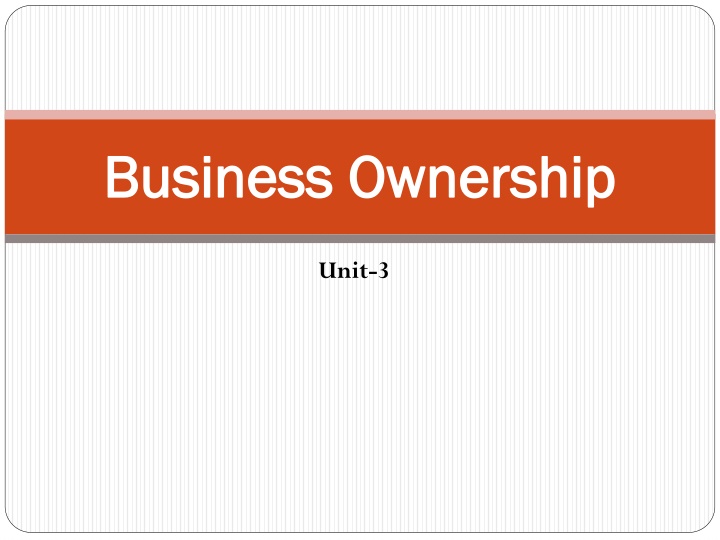Exploring Types of Business Ownership
Understanding various types of business ownership such as Sole Proprietorship, General Partnerships, and their advantages and disadvantages. Learn about the control, liabilities, and decision-making processes involved in each type.
Download Presentation

Please find below an Image/Link to download the presentation.
The content on the website is provided AS IS for your information and personal use only. It may not be sold, licensed, or shared on other websites without obtaining consent from the author.If you encounter any issues during the download, it is possible that the publisher has removed the file from their server.
You are allowed to download the files provided on this website for personal or commercial use, subject to the condition that they are used lawfully. All files are the property of their respective owners.
The content on the website is provided AS IS for your information and personal use only. It may not be sold, licensed, or shared on other websites without obtaining consent from the author.
E N D
Presentation Transcript
Business Ownership Business Ownership Unit-3
Types of Business Ownership Sole Proprietorship General Partnerships Limited Partnership Joint Stock Company Cooperative Societies Public Sectors Private Sector companies Limited Liability Partnership
1) Sole Proprietorship 1) Sole Proprietorship Almost every business start as Sole Proprietorship owing to the convenience of business transactions and the relatively small nature of the business. The ownership of the firm lies with a single person, usually who is the whole and sole of the business decision making authority. The proprietors are the ones who usually own the assets of the business and profits generated by them entirely. The downside of it is they also have to take responsibilities of liabilities and debts if any. In the eyes of the public, the proprietor and business are one. The advantage of these types of business ownership is that the businesses are easy to set up under one authority.
1) Sole Proprietorship 1) Sole Proprietorship The proprietors are in complete control of all the decision- making process which makes it easier for public and other stakeholders while dealing with the company. The owners of sole proprietorship receive all the profits of the business which they can reinvest or retain for own use. In the case of the worst-case scenario, the business is easy to liquidate since the authority lies with a single person and reduces multiple decision makings thereby reducing time.
2) General Partnerships 2) General Partnerships Unlike Sole proprietorship, general partnerships involve two or more people as owners of the business. These people are termed as business partners and a legal agreement is made between the partners regarding the legalities of the business including the business aspects, profit division, work and duty division including way out if either or both partners would want to end the partnership and the settlements after that. It is a well-known fact that every partnership ends at some point in time or at the time of crisis if well-outlined processes are not defined. This is classified as one of the successful types of business ownerships if everything works out well.
2) General Partnerships 2) General Partnerships The advantages of General partnership are they are relatively easy to initiate except for the fact that a lot of time has to be invested in developing a partnership agreement. Since all the owners contribute funds for the business, the capital for the business increases substantially. Since diverse people are involved in ownership, it utilizes their talent and skills set to develop various aspects of the business. There are two types of partners which can be present in Partnership business Active Partner one who takes an active part in the business management Sleeping Partner who takes little or no part in business activities
3) Limited Partnership 3) Limited Partnership Limited partnership business ownership involves a combination of the above types of sole proprietorship and General Partnership. There are multiple people listed as owners in limited partnership but the business decision making authority lies with either one or few of the partners and rest all only contribute the funds and share the profits. These are called limited partners and they have liability to the funds invested by them. A limited partnership is relatively easy to form and people with available finances and investors who know nothing about business can invest in it since they will be concerned only with sharing the profits of the business.
3) Limited Partnership 3) Limited Partnership This ensures that there is less interference of other partners in the day to day activities of the business and this itself is the disadvantage of the limited partnership types of business that even though the investors invest money, he would have no say in the management activities.
4) Joint Stock Company 4) Joint Stock Company Coming together of a group of individuals, for the purpose of sharing profits by supplying the capital required to start the business in the form of shares is called Joint Stock Company. Joint Stock types of business overcome most of the disadvantages of partnership types of business. Usually, these types of business consist of more than 20 people. The company is registered by giving it an appropriate name, outlining its vision and mission and registering it with the Registrar of Companies. The shareholders then elect a board of directors who are responsible for making policies, taking decisions and are imbibed with running of the company efficiently.
4) Joint Stock Company 4) Joint Stock Company There are two types of Joint Stock companies: a) Private Limited Companies A Private Limited is very common among all types of companies. The capital for a business is collected from business partners who may be active or sleeping. The Pvt. Ltd. company does not allow sharing or transfer of stocks and restricts public from taking up of shares. There is no need for filing a consent of directors in a Pvt. Ltd. company and it does not need a certificate from the registrar of companies for initiation of business and neither is it required to share Balance sheet or Profit and loss statements or hold an annual general meeting like a public limited company. The only thing a Pvt Ltd company has to do is send a certificate along with returns saying that it does not have more than 50 shareholders. This report is to be sent to the registrar of the companies. The Pvt ltd company resembles any partnership types of business with the advantage of raising large capital investment.
4) Joint Stock Company 4) Joint Stock Company b) Public Limited Company In this type of business, the capital is collected from the public in the form of small amounts of shares having low face value. The requirement is to have a minimum of 7 Shareholders while having no capping on a maximum number of shareholders. Unlike Pvt. Ltd. company, Public Ltd company has to register with the registrar of the companies, have a board of directors for approvals, generate and share balance sheets, profit, and loss statements and conduct Annual general meetings. Public limited types of companies do not have a limit on the transfer of shares but they have to get their accounts audited every year. The biggest challenge in public limited company is to get investors or shareholders and its formalities in initiating of its business. Also owing to the large sum involved, there is a very high possibility of frauds within the organization.
5) Cooperative Societies 5) Cooperative Societies Cooperative societies are private ownership which is an amalgamation of large partnerships as well as features of a corporation. The members of cooperative societies pay for buying shares and the profits are then distributed amongst its members. Each member in Cooperative societies has only one vote which prevents the concentration of power in few hands. Just like Public limited company, cooperative society has a board of directors and conduct periodic meetings of shareholders. The principle behind the formation of cooperative societies is to form cooperation and self-help and to obtain necessities of everyday life at subsidized costs. The advantages of cooperative enterprises are that it is a democratic form of ownership and overheads are lowered as the members of cooperative may provide honorary services and the common man is benefited by cooperative societies.
6) Public Sectors 6) Public Sectors Public sectors come under the types of business ownerships which are entirely owned and managed by the state. They are also companies that are either owned or managed by the state. These types of business ownerships are either fully or partially in the hands of the government and they are the ones who supply goods and services to society. The ultimate control of the public sector remains with the state and it prevents unbalanced growth of industries bringing a regulation. Capital is not an issue with the public sector and expansion of business posses no problem owing to government involvement. Public sectors are accountable to the State legislature and parliament about their results.
6) Public Sectors 6) Public Sectors It is a well-known fact that compared to private businesses, public sectors are not efficient. The public sector is perfect for those industries which require heavy funding and are difficult to manage under the private sector and the availability of capital and raw material is made available easily for them. The disadvantages of the public sector include inefficiency compared to their private counterparts and they usually run in losses due to improper management. Also, there is too much interference from the government in the internal affairs of the company at management levels.
7) Private Sector companies 7) Private Sector companies It is exactly opposite to that of public sector companies are entirely non-governmental organizations. Private sectors do not undertake businesses where profit margins are low or where the business is risky. They are more often than not, run by businessmen from various sector who have an in-depth knowledge of running the business. The profit possibility is very high along with the efficiency while wastage of resources is minimized. The decisions and the approvals, if any, are provided quickly compared to the public sector companies. Another advantage of the Private sector is there is no interference from the Government or politicians in day-to-day business decisions.
7) Private Sector companies 7) Private Sector companies However, the disadvantages of private sector include overexploitation of workers by the companies and often starting of private sector companies requires huge capital investment, bringing which is very challenging. These types of business owners also lead to the accumulation of profits in selected few hands.
8) Limited Liability Partnership 8) Limited Liability Partnership Although it is a form of partnership, it is classified separately in types of business ownership owing to its popularity and recent interest of many upcoming companies in forming the same. Abbreviated as LLP, these companies are for a limited time on a contractual basis. Usually, two partners are involved in limited liability partnership one of which is an investor and other provides brand name and products but the later does not have any contractual obligations towards liabilities and only first partner would be responsible for liability. This kind of business structure is used by most of the lawyers and accountants, along with few businesses.
Types of Companies Types of Companies Companies Limited by Shares Companies Limited by Guarantee Unlimited Companies One Person Companies (OPC) Private Companies Public Companies Holding and Subsidiary Companies Associate Companies Companies in terms of Access to Capital Government Companies Foreign Companies Charitable Companies Dormant Companies Nidhi Companies Public Financial Institutions
Companies on the Basis of Liabilities Companies on the Basis of Liabilities a) Companies Limited by Shares Sometimes, shareholders of some companies might not pay the entire value of their shares in one go. In these companies, the liabilities of members is limited to the extent of the amount not paid by them on their shares. This means that in case of winding up, members will be liable only until they pay the remaining amount of their shares. b) Companies Limited by Guarantee In some companies, the memorandum of association mentions amounts of money that some members guarantee to pay. In case of winding up, they will be liable only to pay only the amount so guaranteed. The company or its creditors cannot compel them to pay any more money.
Companies on the Basis of Liabilities Companies on the Basis of Liabilities c) Unlimited Companies Unlimited companies have no limits on their members liabilities. Hence, the company can use all personal assets of shareholders to meet its debts while winding up. Their liabilities will extend to the company s entire debt.
Companies on the basis of members Companies on the basis of members a) One Person Companies (OPC) These kinds of companies have only one member as their sole shareholder. They are separate from sole proprietorships because OPCs are legal entities distinct from their sole members. Unlike other companies, OPCs don t need to have any minimum share capital. b) Private Companies Private companies are those whose articles of association restrict free transferability of shares. In terms of members, private companies need to have a minimum of 2 and a maximum of 200. These members include present and former employees who also hold shares.
Companies on the basis of members Companies on the basis of members c) Public Companies In contrast to private companies, public companies allow their members to freely transfer their shares to others. Secondly, they need to have a minimum of 7 members, but the maximum number of members they can have is unlimited.
Companies on the basis of Control or Companies on the basis of Control or Holding Holding a) Holding and Subsidiary Companies In some cases, a company s shares might be held fully or partly by another company. Here, the company owning these shares becomes the holding or parent company. Likewise, the company whose shares the parent company owns becomes its subsidiary company. b) Associate Companies Associate companies are those in which other companies have significant influence. This significant influence amounts to ownership of at least 20% shares of the associate company.
Companies in terms of Access to Companies in terms of Access to Capital Capital When we consider the access a company has to capital, companies may be either listed or unlisted. Listed companies have their securities listed on stock exchanges. This means people can freely buy their securities. Hence, only public companies can be listed, and not private companies. Unlisted companies, on the other hand, do not list their securities on stock exchanges. Both, public,as well as private companies, can come under this category.
Other Types of Companies Other Types of Companies a) Government Companies Government companies are those in which more than 50% of share capital is held by either the central government, or by one or more state government, or jointly by the central government and one or more state government. b) Foreign Companies Foreign companies are incorporated outside India. They also conduct business in India using a place of business either by themselves or with some other company. c) Charitable Companies (Section 8) Certain companies have charitable purposes as their objectives. These companies are called Section 8 companies because they are registered under Section 8 of Companies Act, 2013.
Other Types of Companies Other Types of Companies d) Dormant Companies These companies are generally formed for future projects. They do not have significant accounting transactions and do not have to carry out all compliances of regular companies. e) Nidhi Companies A Nidhi company functions to promote the habits of thrift and saving amongst its members. It receives deposits from members and uses them for their own benefits. f) Public Financial Institutions Life Insurance Corporation, Unit Trust of India and other such companies are treated as public financial institutions. They are essentially government companies that conduct functions of public financing.
Oligarchy In Company Management Meaning of Oligarchy: By Oligarchy we mean control by few. Company may be owned by large number of persons but only a few of them attain position and power to exploit the large body of shareholders and turn the company into a vested interest of their own. Directors, their henchmen and the top executives are likely to abuse their powers, manipulate the finances, deceive the shareholders, pressurise the labourers and swindle the consumers. The management may use the company to grind its own axe at the cost of shareholders in particular and of the community of consumers, workers etc., in general.
Causes of Oligarchy in Company Causes of Oligarchy in Company Organization Organization Cause of Oligarchy # 1. Indifference of Shareholders: In theory, shareholders are the masters of the company but in actual practice they are often only sleeping partners who hardly rouse from sleep to do something tangible. Since they are guided by the principle of spreading their risks, they hold shares of several companies instead of one.
Causes of Oligarchy in Company Causes of Oligarchy in Company Organization Organization Cause of Oligarchy # 2. Ineffectiveness of Shareholders at Meetings: The Companies Act requires the holding of an Annual General Meeting of the company and gives the shareholders the power to exercise their rights at the meeting. But practically the majority of shareholders find it inconvenient to attend such a meeting because of their indifference, apathy, ignorance, very little stake and regular receipt of satisfactory dividends which make them believe that everything is going on smoothly.
Causes of Oligarchy in Company Causes of Oligarchy in Company Organization Organization Cause of Oligarchy # 3. Absence of Unity among Shareholders: The practice of scattering of savings in a large number of companies leads to small holdings by individual shareholders in several companies. As a result of this fragmentation and scattering of savings the vast majority of shareholders usually hold very small share in the total voting capital and are thus unable to influence decisions. Moreover, the vast number of small shareholders, being widely dispersed, cannot organise themselves for concerted action. On the other hand, the inner group , the group controlling the management is well-knit and fully organised and can easily manage to get their decisions approved.
Causes of Oligarchy in Company Causes of Oligarchy in Company Organization Organization Cause of Oligarchy # 4. Election of Directors is a Farce: The directors are the shareholders appointees. This is merely a theoretical proposition. In practice this in not true. A contest for election for a director is a rare event. In actual practice, the directors choose themselves or they are the nominees of the inner group . The fact is that the shareholders elect the directors but they do not choose them. The shareholders merely confirm the election of the directors.
Causes of Oligarchy in Company Causes of Oligarchy in Company Organization Organization Cause of Oligarchy # 5. Non-Voting Shares: Preference shareholders have no voting rights. Only equity shareholders have the voting rights. Thus, there is limited franchise. Preference shareholders and debenture- holders who provide large funds to the company have no voice in the management of the company. As a result, the directors can hold office with the support of a small section of shareholders.
Causes of Oligarchy in Company Causes of Oligarchy in Company Organization Organization Cause of Oligarchy # 6. Closure of the Register: The share transfer Register is closed much in advance of the Annual General Meeting. As a result, the names of the transferees are not recorded in the Register and genuine shareholders are debarred from exercising their voting rights.
Causes of Oligarchy in Company Causes of Oligarchy in Company Organization Organization Cause of Oligarchy # 7. Misuse of Proxies: There is a provision in the Companies Act for proxy voting. Proxy forms are sent to the shareholders before the Annual General Meeting. Most of the shareholders do not attend the meeting personally but authorize proxy to vote on their behalf. The shareholders do not care whether the proxy forms are being properly utilised for voting purposes or not. Under these circumstances, the inner group manages to get their people appointed as proxies.
Causes of Oligarchy in Company Causes of Oligarchy in Company Organization Organization Cause of Oligarchy # 8. Withholding Adequate Information from Members: Many shareholders are relatively uninformed about the business of the company. Very often the management provides information which is either incorrect or inadequate. The management may report the working of the company in such a way that what is good is broadcast and that which is bad but material to shareholders is kept back.
Causes of Oligarchy in Company Causes of Oligarchy in Company Organization Organization Cause of Oligarchy # 9. Big Corporate Business Houses: The study of management in different countries shows that there has been a concentration of economic powers in the hands of a few big business houses and industrial groups. The prevailing oligarchy in company management can be traced to these groups.























